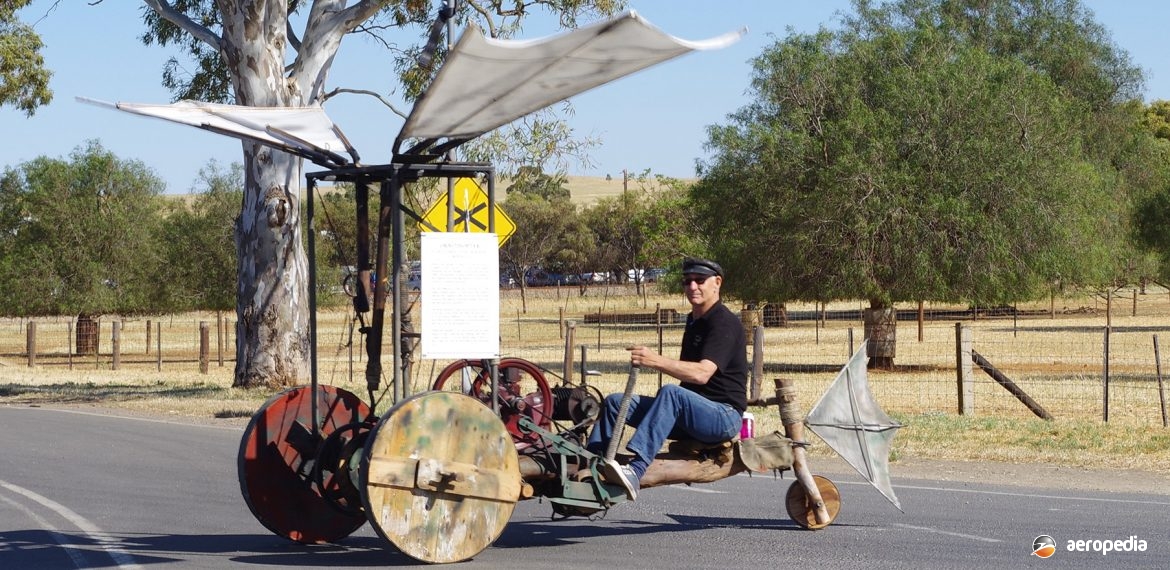Photograph:
Australian-built Ornithopter at the Jamestown Airshow, SA in October 2015 (David C Eyre)
Country of origin:
International
Description:
A heavier-than-air aircraft with flapping wings
Power Plant:
Specifications:
- TBA
History:
The Ornithopter is described in the Collins English Dictionary as “a heavier-than-air aircraft sustained in and propelled through the air by flapping wings.” The name comes from the Greek word ‘ornithos’, which means ‘bird’ and the word ‘pteron’ which means ‘wing’. Over the centuries man has attempted to imitate the flapping wings of birds and many attempts have been made to build a machine to meet this role, many being small scale up to light aircraft size but mostly the size of large birds. Many over the years have been man-powered but a couple have had internal combustion piston engines.
Some of the early attempts were made as far back as the 12th Century and Leonardo da Vinci in the late 1400s studied the flight of birds extensively and prepared many designs. In 1841 an ironsmith in Belgrade (now in Serbia) built a machine which was described as an Ornithopter which had flapping wings but it was not successful. Some models have been built since 1871 using rubber bands for power and it is believed the first internal combustion engine model flew in 1890. Otto Lilenthal in 1894 studied the flight of birds and constructed an Ornithopter. In recent years designers and inventors have continued to study the flight of birds and make attempts to successfully fly a machine powered by flapping wings.
Noted Australian designer and builder, Lawrence Hargrave, from about 1884 built a number of models of the Ornithopter using various methods to power them, including rubber bands, springs, steam and compressed air. German designer, Alexander Lippisch, in the 1930s constructed and successfully flew small scale Ornithopters powered by internal combustion engines using Hargrave’s design of flapping wings. In the years since, various designers have built models with engines with a wingspan up to 2.4 m (8 ft) and a few have been successfully flown.
An Ornithopter has been built by members of Chapter 25, Port Lincoln, of the Sport Aircraft Association in South Australia and this machine was demonstrated at the Jamestown Airshow in 2015. It is described as a copy of the ‘original Flintstone aircraft’ thought to be around in the early 1800s. The machine was built as close as possible to the original from drawings found in a book in the Archives of the Experimental Aircraft Association in Oshkosh, Wisconsin, USA. A machine known as the Flintsone Ornithoper built by Steven & Joan Hay fitted with a internal combustion engine was demonstrated (non-flying) at the 2003 EAA event at Oshkosh. The main difference is the South Australian machine is powered by a 1905 single-cylinder engine [on loan] whereas the original is believed to have been pedal powered. The engine in the Australian machine is itself described as “quite unique with its hit-and-miss governor operation”.
The Australian flying machine is believed to be one of only two examples of the type in the world, the other being the machine referred to above in the collection of the Experimental Aircraft Association at Oshkosh and is thought to be the one built by Mr and Mrs Hay . Like the American machine, the Australian machine was demonstrated with a wing-walker on top of the machine, this being said to be “traditional in early barnstorming days and is not for the faint hearted. The machine is not particularly fast. Its main design features were short take-off and landing [like a bird] – in fact is even shorter than a bird so that it may not even be noticeable to the untrained eye.”

